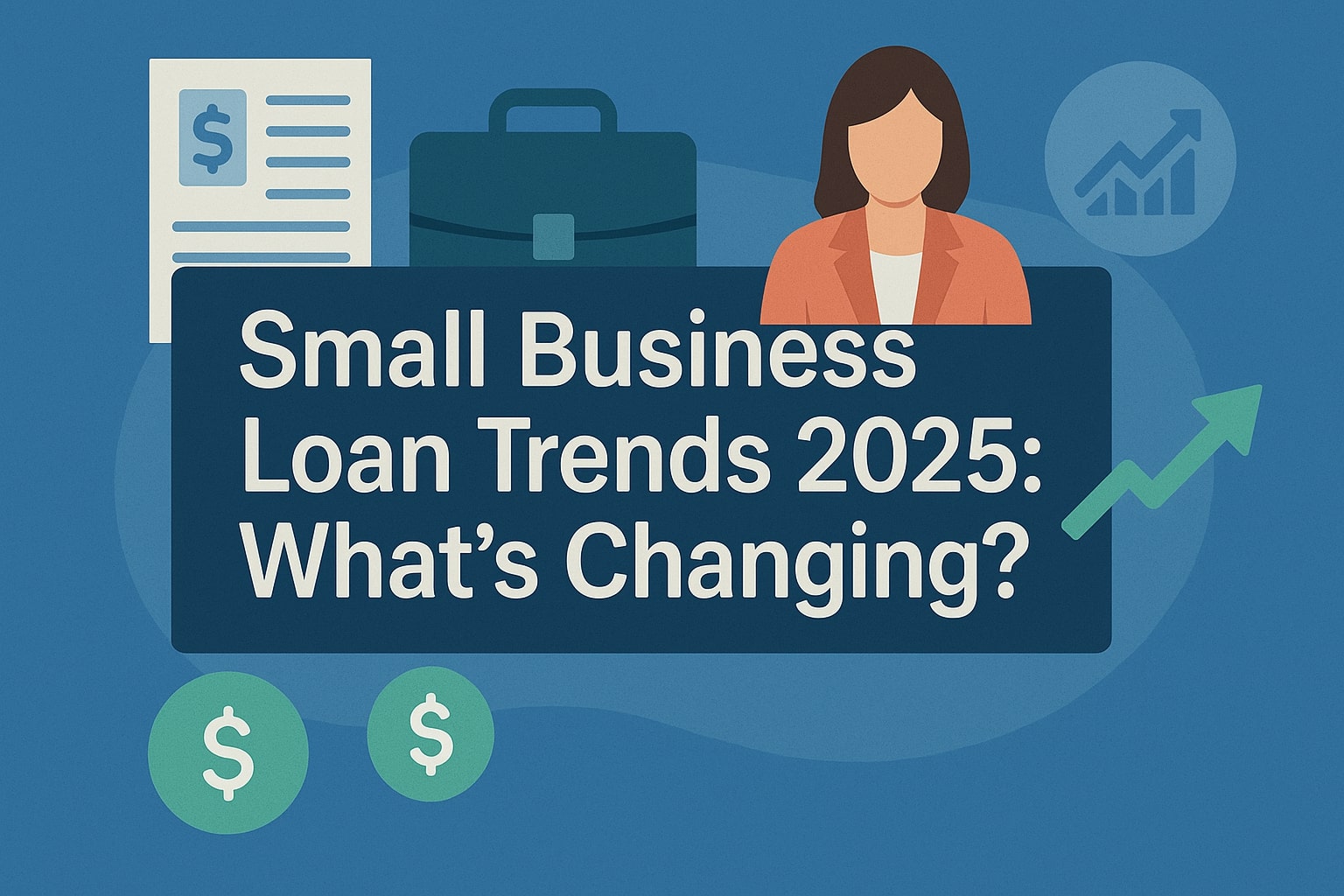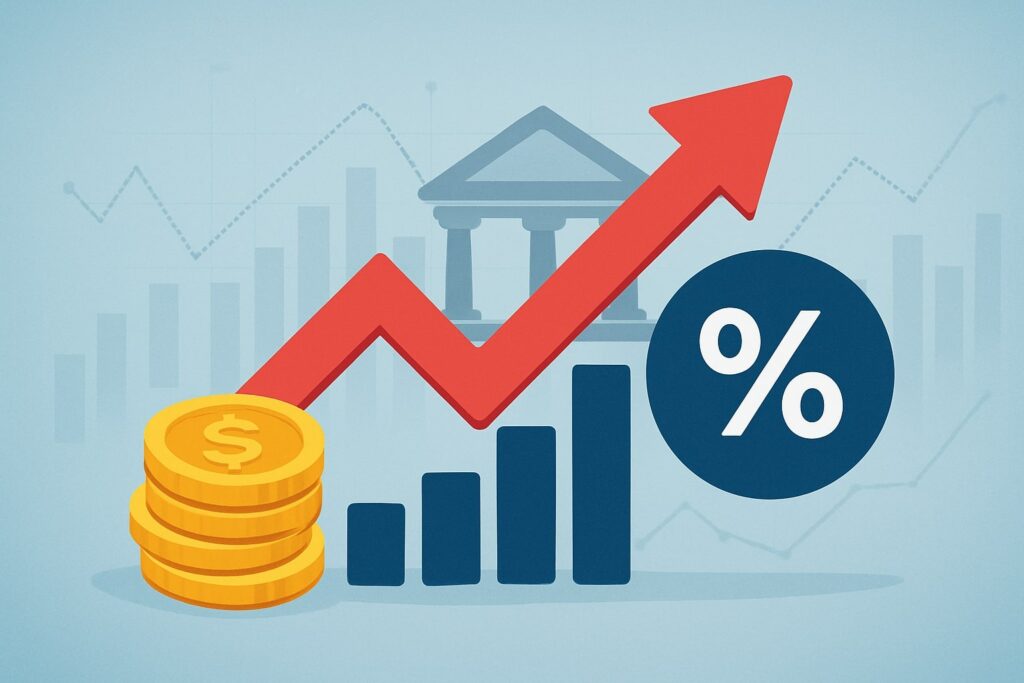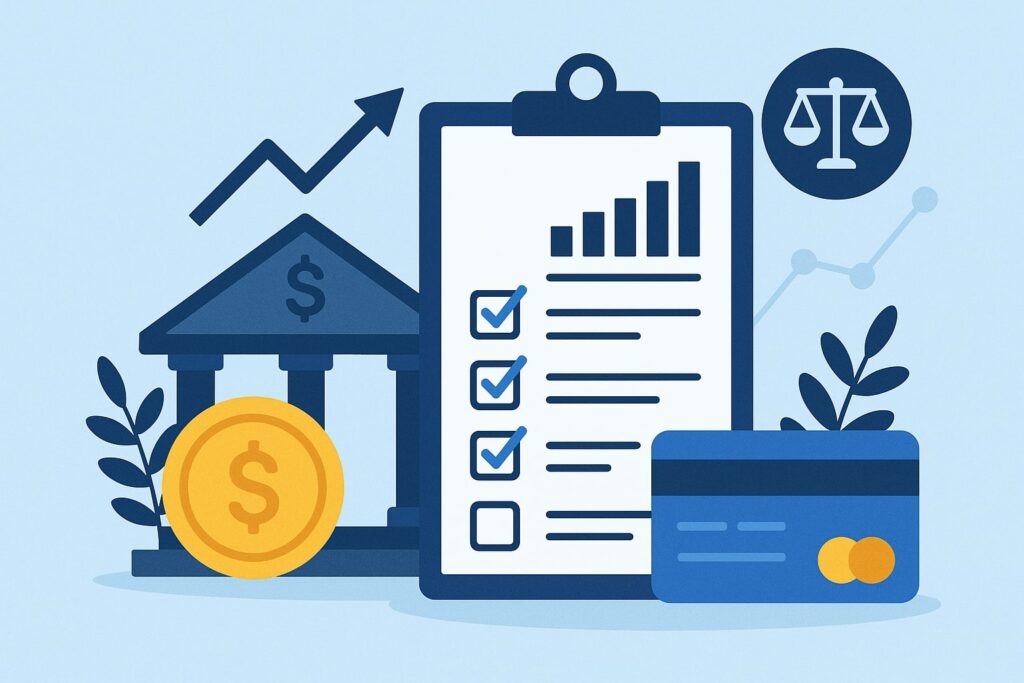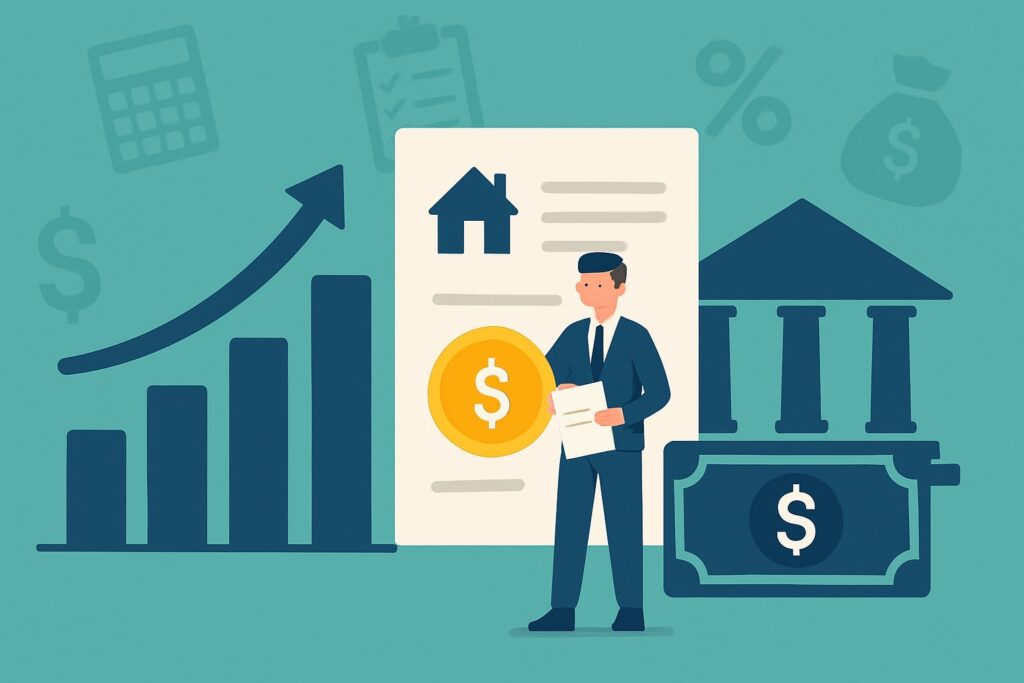
Small Business Loan Trends 2025: What’s Changing?
In 2025, small business loan trends in the United States reflect significant shifts in the financing landscape as the economy adapts to higher interest rates, technological changes, and evolving lender practices.
Business owners, lenders, and investors are watching closely as recent data shows mixed signals: demand for small business credit is rising in some segments even as banks maintain tighter lending standards.
For example, the SBA Office of Advocacy notes that “loan demand is rising” and community bankers report an “improved outlook” for lending, despite persistent rate pressures.
With the Federal Reserve pausing rate cuts in early 2025 (after three cuts in 2024) and predicting at least one further cut late in the year, the cost of borrowing remains elevated but may gradually ease.
This article explores the latest data and expert insights on U.S. small business loans in 2025, covering macroeconomic context, credit conditions, key lending channels (banks, SBA, fintech), and industry-specific developments.
The goal is to give entrepreneurs, lenders, and investors a detailed, up-to-date picture of what’s changing in small business lending across all sectors.
Economic Context and Interest Rates

In early 2025 the economic environment for small business financing is shaped largely by Federal Reserve policy and inflation trends. After aggressive rate hikes through 2022–2023 to combat inflation, the Fed cut rates three times in 2024, with its last move being a quarter-point cut in December.
As of mid-2025, the federal funds rate remains in a 5.25 – 5.50% range, and markets expect at least one more cut later in the year.
Bankrate reports that in the first meeting of 2025, the Fed held the prime rate steady at 4.25 – 4.50% (which is typically prime = fed funds + 3%), and commentary suggests further cuts could come as economic uncertainties (tariffs, trade, labor issues) persist.
Interest rates directly affect small business loans. Currently, U.S. business loan APRs are still relatively high: NerdWallet cites average bank loan rates of 6.6%–11.5% in Q1 2025.
By contrast, SBA loans carry somewhat higher fixed rates (roughly 10.5%–15.5% depending on term), while online and alternative loans span a much wider range (for example, merchant cash advances can cost 40%–350% APR). The chart below summarizes typical interest rate ranges for different small-business loan types:
| Loan Type | Typical APR (Annual % Rate) |
|---|---|
| Traditional Bank Term Loan | 6.6% – 11.5% |
| SBA 7(a) Loan | ~10.5% – 15.5% (varies by term)* |
| Business Line of Credit | 10% – 99% |
| Online Short-Term Loan | 14% – 99% |
| Equipment Financing | 4% – 45% |
| Invoice Factoring | 10% – 79% |
| Merchant Cash Advance | 40% – 350% |
* Fixed vs. variable rates on SBA loans depend on market conditions and loan parameters. These rates (from industry data and surveys) show that small businesses face high borrowing costs in 2025.
Bankrate notes that as the Fed adjusts rates, loan APRs move in tandem: a modest Fed cut of 0.25% could lower the APR on a $300K SBA loan by almost $9,000 in total interest over 15 years.
Conversely, during 2022–24, rising rates drove average SBA loan sizes down by 38% as firms took smaller loans to afford the higher payments. In sum, the high-rate environment has made bank loans more expensive and has nudged some borrowers toward SBA-backed or alternative financing.
Lenders are keeping a close eye on inflation and Fed guidance: many forecasters see inflation moderating to ~2.5–3.0% by late 2025, which could allow more rate cuts.
For now, however, most small businesses view interest rates as a major challenge – indeed a U.S. Chamber survey found 51% of small firms consider rates “too high to afford a loan”.
Credit Conditions and Lending Standards

Despite some easing of headline interest rates, banks have kept credit standards tight through early 2025. Federal Reserve regional surveys indicate that small business loan standards have been tightened for well over a year.
For example, the Kansas City Fed’s quarterly survey of banks reported that by Q1 2025 credit standards tightened for the 14th consecutive quarter.
In the Tenth Federal Reserve District (Kansas City Fed’s region), the Q1 2025 report notes that “credit standards tightened for the fourteenth consecutive quarter and credit quality declined for the twelfth consecutive quarter”.
Similarly, the prior quarter’s survey (Q4 2024) showed standards tightened for the 13th quarter in a row. Tight standards mean banks are being more selective: higher collateral or stronger cash-flow requirements, and lower loan-to-value on property, are common.
In national terms, the FDIC’s 2025 Risk Review also observed that “small businesses reported tighter financing conditions” in 2024.
The FDIC noted community banks remain key small business lenders, but overall loan growth slowed as banks “tightened lending standards” amid economic uncertainties.
Consistent with that, the Fed’s Senior Loan Officer Survey (February 2025) showed commercial lending demand eased and credit remained tight.
All in all, the recent data suggest that banks are cautious: even as small firms need capital, many banks are reluctant to loosen terms until economic signals are clearer.
At the same time, the cost of credit has weighed on borrowers. High rates mean higher debt-service, so even creditworthy firms may borrow less.
For example, a Bankrate analysis found that because of rising rates, the maximum loan a firm could afford on a given monthly payment has declined.
This is one reason the average SBA loan size fell sharply: with a 0.25% higher APR, the example SBA loan principal dropped by thousands. The combination of tight credit and higher rates has put some squeeze on cash-strapped businesses.
However, banks report that asset quality (delinquencies) has not yet spiked: the Kansas City Fed survey respondents indicated they do not expect existing loan performance to force much change in new standards.
Likewise, the FDIC noted that while small business lending “slowed,” the asset quality of community bank C&I loans (often used by small firms) remained “relatively sound” through 2024. In short, lenders are deliberately cautious but thus far have avoided a major deterioration in loan quality.
Loan Demand and Volumes

How much credit are small businesses seeking in 2025? Surveys paint an interesting picture of loan demand. In late 2024, banks finally saw a pickup in demand after a two-year lull.
The Q4 2024 Kansas City Fed survey reported that loan demand increased for the first time since early 2022. That uptick coincided with the Fed starting to cut rates.
In Q1 2025, the Kansas City Fed noted mixed outcomes: loan demand rose and approvals were up at midsize and large banks, but demand and approvals declined at small banks.
On balance, about the same number of lenders reported an increase in demand (22%) as those reporting a decrease (21%). Another barometer is the Small Business Lending Index (SBLI) from Equifax, which measures actual loan originations.
Equifax reported that in April 2025 new small-business lending jumped 17.2% month-over-month and 3.4% year-over-year (an important short-term data point).
In general, 2024 saw moderate growth in outstanding loans: Kansas City Fed data show total outstanding U.S. small business loan balances grew roughly 1–1.5% year-over-year by late 2024.
Specifically, outstanding small-business loans were up 1.5% from Q4 2023 to Q4 2024 and up 1.0% from Q1 2024 to Q1 2025. These modest gains suggest loan volumes were fairly flat but expanding slightly, even as standards tightened.
The application rate for new loans also shifted. During the pandemic, traditional bank borrowing surged, then fell as aid programs ended.
According to the Federal Reserve’s Small Business Credit Survey, by 2023 the share of firms applying for traditional financing had “rebounded to pre-pandemic levels” after a dip.
That means roughly the same fraction of small businesses were seeking loans in late 2024 as before Covid-19. However, of those who applied, fewer are getting fully approved.
The SBCS and other sources indicate approval rates have trended downward – for example, only about one-third of applicants got all the financing they requested in 2021.
More recent data (2022–24) suggest tight approval rates continue, especially for newer firms or those with weaker credit scores.
Key Takeaways: Credit Demand and Supply
- Growing Loan Demand: After lagging for two years, loan demand is rising again, especially at larger banks. Lenders report more small businesses are seeking funds for growth and equipment.
- Tight Standards: Credit standards have remained tight through 2024–25, limiting credit growth even amid higher demand. Banks expect careful underwriting to continue.
- Stable Outstanding Debt: Outstanding loan balances grew only modestly (~1% YOY) in late 2024, implying that businesses are not borrowing much more in total.
- High Rates Curb Borrowing: Elevated interest rates mean some firms are waiting for cheaper credit. Surveys show 51% of owners feel rates are too high to take a loan, which dampens demand despite potential need.
SBA and Government-Backed Loan Trends
Government-guaranteed loans, especially through the SBA (Small Business Administration), have been a bright spot in the landscape. SBA programs (7(a), 504, and disaster loans) saw record activity in FY 2024.
The SBA’s Capital Impact Report states that for the fiscal year ending Sep 30, 2024, over 103,000 SBA-backed loans were made – the highest total since 2008 – amounting to $56 billion in capital delivered. That was a 7% increase over FY2023.
This surge was driven largely by growth in smaller 7(a) loans under $150,000 and strong lending to traditionally underserved groups (women-owned and minority-owned businesses).
In other words, SBA’s footprint is expanding as many entrepreneurs seek lower-cost, government-guaranteed financing in a high-rate environment.
SBA loan rates remain competitive relative to banks. In 2024 the average SBA 7(a) interest rate was about 7.5%, notably below typical commercial loan rates (~10% or more). This gap has motivated more borrowers to apply for SBA financing.
Even fintech platforms are facilitating SBA loans more frequently. Industry observers estimate that by late 2024, about 25% of all SBA loans originated through fintech channels (versus 18% prior year), thanks to faster online applications and underwriting.
As 2025 unfolds, SBA officials and community lenders expect SBA demand to remain strong. One outlook projects SBA loan volume could rise another 10–12% in FY2025, reaching roughly $55–56 billion (though these projections come from private analysts).
Policy support is also evolving: Congress and the Biden administration have signaled more focus on tech startups, energy projects, and minority business lending through new SBA initiatives. Any new SBA rules (such as streamlined processes for small loans under $350K) could further boost accessibility.
That said, SBA lending is also subject to economic conditions. Higher Fed rates make fixed-rate SBA loans (especially 504 real estate loans) relatively pricier, which may temper some demand.
Lenders note that many borrowers use SBA only after finding traditional bank terms too costly or restrictive. Still, for 2025 we expect SBA programs to be a key channel for small businesses who seek support – especially for equipment, real estate, or relief from high short-term rates.
Investors and lenders should watch SBA data for early signals: as of 2024, both loan counts and dollar volume are at multi-year highs, indicating pent-up demand.
Fintech and Alternative Lending
“Nonbank” lenders and fintech platforms continue to reshape the small business lending market. Large banks remain the dominant source of most commercial loans, but alternative lenders have seized niche opportunities, especially for smaller, short-term funding.
According to Federal Reserve research, although online lenders still represent a small share of overall small-business credit, they have become “a growing source of small-dollar credit for small businesses”.
For example, many micro-enterprises and startups with limited track records turn to fintech lines of credit, merchant cash advances, or invoice factoring – even at high APRs – because of the speed and ease of approval.
The FDIC Small Business Lending Survey (2022) found that banks are increasingly partnering with fintech in underwriting and funding. Many banks use fintech software to speed up small loan approvals.
Some banks reported co-lending with fintech firms or buying loan portfolios originated by online lenders. The FDIC notes that fintech usage varies by bank size: large banks and institutions in tech hubs use sophisticated digital tools, while small community banks are more cautious but still exploring digital underwriting.
In 2025, the fintech factor is expected to grow even more. Automated underwriting (often AI-driven) is reducing approval times drastically – some lenders claim SBA loan approvals now take “half the time” thanks to data automation.
As businesses adapt to remote work, digital access is a priority: one survey found 58% of small firms now use generative AI tools and nearly the same percentage see AI as a competitive advantage.
Lenders are integrating AI for credit scoring and fraud detection, which should eventually improve underwriting, though regulatory scrutiny is rising.
Alternative debt funds (e.g. private credit funds) also appear in the background, but these usually target larger middle-market firms rather than Main Street small businesses.
For the core audience of small enterprises, the fintech story is more about convenience and choice: many small owners are now aware of marketplace lenders, online brokers, and even Point-of-Sale financing as complements to banks.
In some cases, lenders even collaborate – for instance, some fintechs are approved SBA brokers.
Industry-Specific Lending Trends
While many small-business lending trends are economy-wide, some differences appear across industries. Overall, demand is strongest in certain “growth” sectors and softer in struggling industries. Many lenders report the following patterns in 2024–25:
- Healthcare and Life Sciences: Aging demographics and tech adoption (telemedicine, biotech) are driving investment. Doctors’ offices and clinics have borrowed for equipment (like MRI machines) and facility expansions.
SBA 7(a) and 504 loans have been common for medical/dental practices, with lenders noting sustained demand. - Technology & Innovation: Small tech firms (cybersecurity, software, AI startups) often need capital for R&D and payroll.
Although these firms may have volatile revenue, investors and SBA programs are funding many. Some community banks and Fintechs now have “innovation banking” divisions for startups. - Construction and Manufacturing: The push for reshoring and infrastructure has spurred loans for factories and equipment.
With recent government infrastructure spending, small manufacturers and construction contractors are using credit lines and equipment loans to ramp up capacity. However, these industries are also sensitive to interest rates on long-term projects. - Hospitality and Tourism: Restaurants, hotels and travel services rebounded post-pandemic, but face high operating costs.
Many have used loans (both bank and SBA 504) to upgrade or expand after 2020–21 closures. Demand remains steady, but profit margins are tight. - Green Energy and Sustainability: Driven by tax credits and consumer demand, businesses in solar, EV charging, and retrofits are strong borrowers.
The SBA and banks have green-focused loan products (including SBA’s separate “504 green loan” program), and financiers report many applications from this sector. - Retail and Commercial Real Estate: Traditional retail shops and brick-and-mortar services remain under pressure from e-commerce and remote work.
Loan demand in these sectors is more limited, and lenders see higher risk. Many retailers are cutting back expansion plans. Office real estate loans are also weak as vacancy rates stay high. - Agriculture: Crop and farm borrowers have faced volatile commodity prices and weather events. The FDIC notes tighter liquidity among agricultural borrowers and some loan quality deterioration, especially for corn/soybeans.
However, farm credit institutions continue lending (often with favorable government programs) and delinquency remains modest for now.
These industry trends highlight the fact that “small business” is not monolithic. Lenders tailor loan programs by sector. For instance, construction and equipment loans (term loans or leasing) are common in manufacturing, while lines of credit are used in retail for inventory.
SBA 504 real estate loans see more use in healthcare and hospitality. Entrepreneurs should be aware that sectors with solid growth (tech, health, green energy) may find lenders more eager, whereas legacy sectors face stricter scrutiny.
How Small Businesses Can Navigate 2025
Given the changing landscape, what can business owners do? Key steps include:
- Shop Around for Loans: With so many options (traditional banks, credit unions, SBA, online lenders), compare costs and terms.
Even small rate differences matter: e.g. lowering APR by 0.25% can reduce a $300K loan’s interest by thousands. Use SBA or alternative lenders if traditional banks reject you. - Prepare Strong Documentation: Banks are choosier, so prepare clear cash-flow statements and collateral. Highlight stable revenues or contracts. For SBA loans, working closely with a certified counselor or fintech broker can speed approvals.
- Consider Government Programs: Check for new SBA initiatives or local/state loan programs (some provide rate subsidies or guarantees). Be aware of any tax incentives or credits (e.g. energy investments) that may indirectly improve your financing terms.
- Manage Debt Levels: The FDIC advises that small businesses keep debt burdens manageable (US banks’ small-biz debt held steady, but businesses still feel squeezed).
Focus on maintaining cash reserves to weather slower growth and avoid over-leveraging. - Embrace Technology: Use fintech tools (like online loan marketplaces or AI credit analytics) to find better deals.
For lenders: adopting AI underwriting can speed decisions and lower costs; for borrowers: utilizing modern accounting and credit platforms can improve loan approvals.
Table 1. Typical APR ranges for small business loan types (U.S., 2025). Data sources: Federal Reserve surveys and industry reporting.
| Loan Type | Approximate APR (rate) |
|---|---|
| Traditional Bank Term Loan | 6.6% – 11.5% |
| SBA 7(a) Loan (fixed/var.) | ~10.5% – 15.5% |
| Business Line of Credit | 10% – 99% |
| Equipment Financing | 4% – 45% |
| Invoice Factoring | 10% – 79% |
| Merchant Cash Advance | 40% – 350% |
Notes: APR = annual percentage rate. Rates vary by creditworthiness, loan size, and term. SBA loan rates are typically lower than bank loan rates for comparable terms.
Frequently Asked Questions
Q: How will federal interest rate changes affect small business loans in 2025?
A: The Fed’s actions set the cost of credit. After high rates in 2022–24, the Fed paused hikes and even cut rates thrice in 2024. In 2025, markets are pricing in at least one or two modest rate cuts in H2.
When the Fed cuts, bank lending rates and prime rates generally follow, which would lower APRs on new loans. For example, Bankrate analysis shows even a 0.25% reduction in APR can materially reduce interest costs on multi-year loans.
So if inflation eases as expected, small business borrowing costs should edge down. However, any cuts are likely gradual; small firms should plan with current rates in mind.
Q: Are banks easing up on lending standards?
A: Not significantly – banks remain cautious. Data from Federal Reserve surveys show credit standards continued tightening through early 2025. Community banks and large banks alike have raised requirements due to economic uncertainty.
Lenders report they will continue monitoring loan performance closely. That said, survey results indicate most bankers do not expect current loan losses to force widespread tightening in the next quarter. So standards likely stay tight, but should not worsen rapidly unless the economy deteriorates.
Q: What role do fintech lenders play in 2025 for small businesses?
A: A growing one. Fintech and online lenders have filled gaps left by banks, especially for small-dollar or short-term financing. Studies show online lenders are becoming an important source for small businesses.
Many banks now partner with fintechs for underwriting and loan origination. Entrepreneurs often use fintech lines of credit or term loans when banks turn them down; these come with higher APRs but faster decisions.
In 2025, expect fintech lending to continue expanding: AI-driven approval processes and digital platforms are attracting more small businesses. Lenders are also leveraging fintech tools internally. In short, fintech is not replacing banks, but it is a fast-growing supplement in small business lending.
Q: How do trends differ across industries?
A: Demand for loans varies by sector. Sectors tied to growth and innovation – healthcare, technology, green energy, manufacturing – are seeing strong financing activity (loans for new equipment, facilities, R&D, etc.).
Conversely, traditional retail and commercial real estate remain weak borrowers due to e-commerce and remote work trends. Agricultural borrowers have faced higher costs and some tighter lending, though overall farm debt is still manageable.
It’s important for lenders and investors to analyze sector-specific risks and opportunities. For instance, a new telehealth startup’s loan might be assessed very differently than a downtown restaurant’s loan.
Q: What is the outlook for SBA loans in 2025?
A: Very active. SBA loan volumes hit historic highs in FY2024 and are expected to remain elevated. Lower overall rates on SBA loans make them attractive when commercial rates are high.
The SBA and Congress are also focusing on new programs (for tech startups, energy projects, underserved entrepreneurs) that could boost demand.
While final numbers won’t be known until FY2025 ends, analysts anticipate continuing growth in SBA-backed loans, especially as borrowers seek to “lock in” favorable fixed rates before any further Fed hikes. As one source puts it, the SBA loan market is poised to grow ~10–12% to ~$56B.
Conclusion
As 2025 progresses, the small business lending landscape in the U.S. is in flux. Borrowing costs remain elevated from prior rate hikes, and banks continue to tighten credit standards, but loan demand is resurfacing in key sectors and through alternative channels.
SBA-backed credit is at historically high levels, fintech platforms are capturing more of the market, and policymakers are eyeing further Fed rate cuts that could ease credit costs.
For business owners, the advice is to plan carefully: stay informed of interest rate forecasts, prepare strong loan applications, and explore all financing options (including SBA and fintech) to secure the capital needed.
Lenders and investors, meanwhile, should monitor credit quality closely even as they tap into new markets – sectors like technology and renewable energy show promise, whereas others like traditional retail warrant caution.
In all, “what’s changing” in 2025 is a mix of challenges and opportunities: interest rates and lending terms may soften later in the year, but the lessons of recent tight credit mean that managing financial leverage and cash flow prudently is more important than ever.
By leveraging up-to-date data and flexible strategies, small businesses and their financiers can navigate the evolving loan trends successfully.